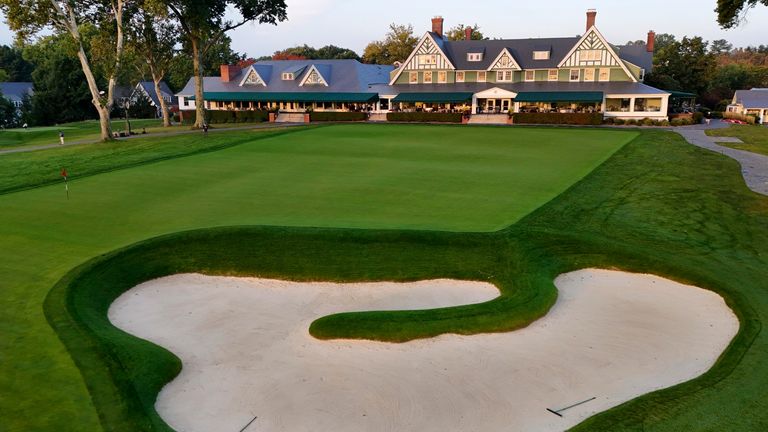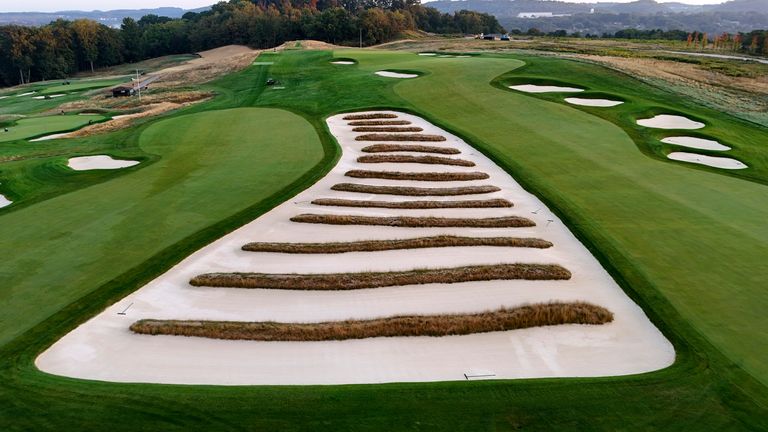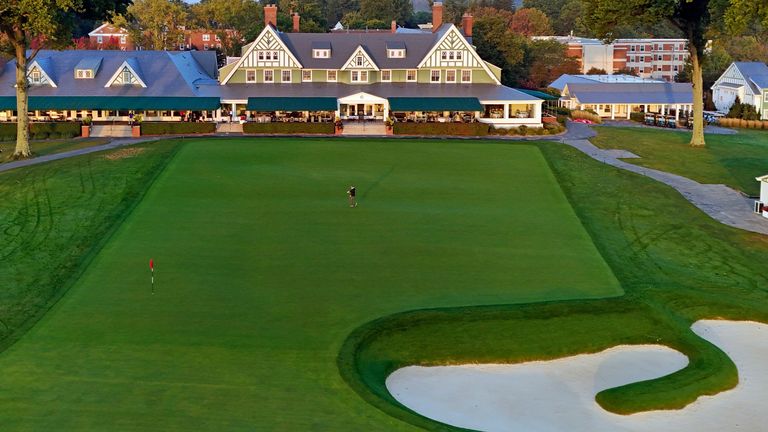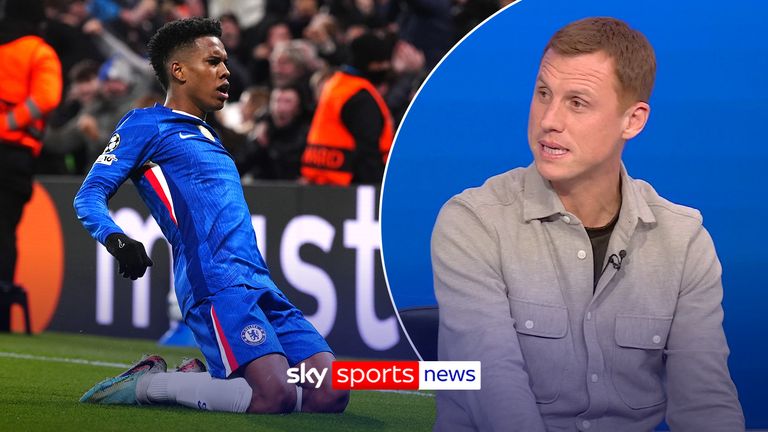
Oakmont Country Club describes itself as “The ultimate examination of Championship golf” – an early indication of the brutal challenge the world’s best will face this week at the US Open.
The Pennsylvania course hosts the third men’s major of the year for a record 10th time, nine years on from Dustin Johnson’s US Open victory at the venue, with the par-70 layout historically offering one of the toughest tests in golf.
Six-time major champion Phil Mickelson described the course as “the hardest golf course we’ve ever played” ahead of the 2016 contest, where only four players finished the week under par despite heavy rain and storms in the early rounds softening the course.
Angel Cabrera finished on five over par when he claimed US Open victory at Oakmont in 2007, with an over-par winning score a possibility once again at a venue former champion Geoff Ogilvy once referred to being “like the hardest hole you’ve ever played on every hole.”
The United States Golf Association (USGA) traditionally sets up US Open courses to challenge all facets of a players’ game and punish mistakes, with Johnson’s opening-round 67 in his 2016 success the only bogey-free total out of 443 official rounds recorded that week.
“It [playing a US Open] is just a battle, it really is,” said Xander Schauffele, who has finished no worse than 14th in eight US Open appearances. “It can be extremely rewarding if you are able to stay disciplined for 72 holes.
“The cliché statement of golf is a marathon, it seems to be the most true feeling when you play at US Opens. You just feel like you’re going to war every day.”
The course has been set up around 150 yards longer than it did nine years ago, measuring at 7,372 yards for this year’s contest, with both par-fives with a maximum distance of over 600 yards.
“If you’re a 10-handicapper, there is no way you’re breaking 100 out there,” former world No 1 Tiger Woods said during his Oakmont appearance in 2007. “If you played all out on every shot, there is no way.”
The average fairway width around Oakmont is 28 yards, with some even more narrow, with those missing the fairways facing playing out of rough that is set be five inches thick or from one of 168 bunkers.
“Complete guesswork out of there,” was defending champion DeChambeau’s assessment of the rough during a practice round, which he filmed for his YouTube channel. “That [lie] is cooked beyond belief. That’s more than half-baked there. That’s burnt to a crisp!”
Golfweek’s Eamon Lynch reported that Adam Scott was three over for his front nine during a practice round at Oakmont, despite hitting every fairway, while also saying Rory McIlroy posted a triple-bogey seven on the second hole of his scouting mission.
“This front nine just eats you up,” DeChambeau added. “Oakmont, you’re a beast!”
The course is home to the longest par-three in major golf, with the eighth hole playing at a staggering 300 yards in 2007 and set up at 289 yards – a length that could be considered a short par-four for many amateurs – for this year’s contest.
“Yeah, that’s not my favourite hole in the world,” two-time major winner Justin Thomas said. “I think you could do some other things with that. But everyone’s going to have to play the same hole and going to have to execute the same shots, and I would love four threes on it right now if I could take it.”
Finding long fairways and greens in regulation still leave work to make pars or better around Oakmont, which has greens former USGA boss Mike Davis described as the “scariest” in golf.
Hard, fast and undulating putting surfaces are expected to measure just under 15 on the Stimpmeter – a device used to measure the speed of a green, which is considerably quicker than the 12 or 13 feet traditionally expected on the PGA Tour.
“You can’t let your mind slip on these greens for one moment, or else you’re going to be left with possibly a 10- to 15-footer on the next putt, if not worse,” former US Open champion Jordan Spieth previously said about the greens.
Gene Sarazen, Sam Snead, Ben Hogan, Jack Nicklaus and Ernie Els are all former winners at Oakmont, while whoever adds their name to that illustrious list will certainly have earned their first prize in excess of $4.3million (£3.17m).
More scores in the 80s than in the 60s? More four and five-putts than long-range putts holed? Those who enjoy seeing the world’s best struggle will relish the chaos and drama expected this week.
Hole-by-hole course guide
All yardages are based on the US Open media guide; Guide written by PA media
First – 488 yards, par-four: A really demanding opener, with the second shot blind to a green that slopes from front to back.
Second – 346 yards, par-four: Many players take an iron off the tee with a ditch left and bunkers right, but downwind some will try to get as close as they can to a green where three putts are common.
Third – 462 yards, par-four: The famous Church Pew bunkers are left of the fairway and the bunkers on the right are no fun either. The elevated green is relatively flat by Oakmont standards.
Fourth – 611 yards, par-five: The Church Pew bunkers again come into play and further traps in the right rough are very severe. Despite the length of the hole, driver might not be the best option off the tee due to the premium on accuracy.
Fifth – 408 yards, par-four: Irons for position the usual course of action, leaving an approach to one of the most undulating greens.
Sixth – 200 yards, par-three: The first of the short holes offers little respite. with a small green which slopes from right to left.
Seventh – 485 yards, par-four: Another hole where par is a real achievement. Left of the green is the main danger, while the putting surface itself is angled severely from left to right.
Eighth – 289 yards, par-three: The longest par three in major history. The green might well be out of reach for some, while anything slightly left is likely to find Sahara bunker that is 100 yards long.
Ninth – 472 yards, par-four: Plays as a par five for club members with a blind uphill drive which must avoid a ditch left and pot bunkers right. Another demanding green.
10th – 461 yards, par-four: The first hole on the back nine plays downhill, but players must find a narrow fairway and make sure to avoid the bunkers down the right.
11th – 400 yards, par-four: Usual approach involves an iron or three-wood to reach a plateau on the fairway, leaving an approach to a green which slopes from back to front.
12th – 632 yards, par-five: Longest par five ever in majors when it played to 667 yards in 2016 and strategy will play a big part. As with the fourth hole some may keep driver in the bag, even though it will mean a far longer third shot.
13th – 182 yards, par-three: Hourglass green is very narrow and the crucial thing is to leave an uphill putt.
14th – 379 yards, par-four: Driveable in favourable conditions and the forward tee. Making birdie or even eagle, though, depends on coping with a large green that has a lot of subtlety to it.
15th – 507 yards, par-four: Blind tee shot to a fairway that slopes left to right. More Church Pew bunkers down the left, with ditches and further bunkers on the right.
16th – 236 yards, par-three: The large green slopes left to right and while much shorter than the eighth, it could prove the tougher of the two.
17th – 312 yards, par-four: An opportunity to make up lost ground, but there are risks attached. Bunkers lie in wait 50 yards short of the green on the left-hand side.
18th – 472 yards, par-four: One of the toughest closing par fours in golf. Long and straight shots needed for both the drive and the approach to an undulating green.
Who will win the US Open? Watch extended coverage throughout the week live on Sky Sports, with the opening round live on Thursday from 12.30pm on Sky Sports Golf. Get Sky Sports or stream no contract on NOW.
This news was originally published on this post .













Be the first to leave a comment